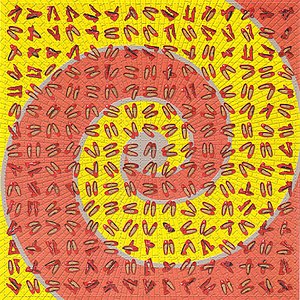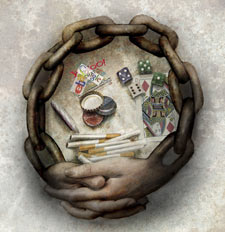Furthur: For A New Generation of Psychonauts
Welcome to the circle! Ask a question, give your opinion, or share a story. Since you can't pass a joint through fiberoptic cable, help me show you some love by commenting!
Thursday, August 16, 2012
Video: Do you really need a grinder?
I just made a video of my popular post about grinders, because people seem to be really curious about the subject. Enjoy!
Tuesday, July 31, 2012
Quick Trip Report: 7/28/12
 |
| One "Blotter" sheet of 225 LSD doses. (Photo credit: Wikipedia) |
Once we all dropped it, I became pretty convinced that it was NOT LSD. When I asked on Reddit, I was told that it was most likely an NBROMe, but if you believe differently once I describe it, please tell me in the comments, because I am passionately curious.
Before I really review the substance, I'd like to make a disclaimer: I barely tripped at all. Reddit and I chalk this up to uneven distribution on the strip, but I just had a small body high and a little visual distortion. I will be describing the experiences of others, mainly, based on what they say and what I observed at the time.
We were told by the dealer that it was "time capsule acid," and that they had dug it out from hiding specifically for this year's bicycle day. I was not there when they bought it, and I don't think my comrades knew that that really wasn't a selling point because LSD is such a fragile chemical. But either way, we weren't going to be picky, so we bought 3 strips for about $85 each.
By the time my group of friends and I assembled at our house in the evening, C was already tripping. Her body language had changed, and she was VERY clammy to the touch. She was startled at noises, and kept saying that she was tripping really hard. She wandered off to a friend's house, and the rest of us took our tabs. Beforehand, I should mention, that based on rumors H had heard and my own strange personal experience, we drank a shit ton of mango orange juice. J (male) took about one tab (I had to cut it myself, and was just eyeballing), I took 1.5 or 1.75, and K (also male) took two.
I immediately noticed a strong bitterness. I really couldn't stand the taste, so I swallowed it immediately and washed it down with a few french fries. As soon as this happened, I became suspicious that it wasn't LSD. LSD will normally The rest of them said it was just because the paper was dyed and we usually get plain white paper, but I know how acid tastes and how it feels in your mouth, and that wasn't it. (My immediate swallowing may also have something to do with why I didn't really trip-- thoughts?)
I also noticed some nausea. I have a phobia of vomit, so I just suppressed it and figured that it was just a product of my brain. After about an hour, I began to get kind of a body high-- just a greater sense of body integrity, and an almost play-doh feeling. By this time, J was already tripping. I know him well enough to see it in his facial expression.
About three hours after dosing ourselves, K and I went for a walk to get some Chinese food. (Another difference; I found myself able to eat and sleep on this substance.) On the walk there, I ran into an old RA of mine, and had a totally normal conversation, obviously still pretty sober. K started feeling effects at this time, and pointed out how strange to him the faces painted on the buses looked.
After another 2 hours, I noticed some visuals: shadows started to look like other things, for example, people. My behavior was also a little different: I was less shy and a little bubbly or giddy. About 6 hours after dosing, I was exhausted and went to bed. I thought a little bit about how time is money (definitely psychedelic thoughts, but nothing mind-blowing) and then went to sleep. Later in the night, when J came in and turned the lights on and off, I did have closed-eye visuals. Instead of the usual bubbly or soft LSD patterns, they were twisty and detailed and strange, closer to shrooms but less "organic." When I woke up in the morning, I had an odd "hangover." I felt like total shit. Nobody else reported this.
The next night, N and H decided to trip and I stayed up with them. It was H's first trip, and I think they took one tab each. They had already heard my theories about the substance not being LSD, and eventually agreed. N experienced some extreme nausea, and his trip kicked in within 15 minutes. He also experienced some odd temperature fluctuations like I observed with C. We just stayed up all night talking and looking at weird bugs on the internet. In the morning, he agreed that it was certainly not LSD.
If you have any experience with research chemicals, please let me know!
Posted by
Unknown
at
1:17 PM

Quick Trip Report: 7/28/12
2012-07-31T13:17:00-04:00
Unknown
Drugs|Hallucination|LSD|Lysergic acid diethylamide|NBROMe|Psychedelics|Recreation|Reddit|
Comments
Labels:
Drugs,
Hallucination,
LSD,
Lysergic acid diethylamide,
NBROMe,
Psychedelics,
Recreation,
Reddit
Wednesday, May 23, 2012
Does Marijuana Withdrawal Exist?
As the controversial new psychological diagnosis manual, the DSM-5, is being debated and discussed by prominent psychologists, many changes have been put into the limelight, including the inclusion of cannabis withdrawal as a disorder. The concept of marijuana withdrawal is a controversial one-- some say it doesn't exist, and others say that it's an important part of marijuana. If it does exist, it is certainly subtle. It seems to be that only opponents of cannabis use acknowledge its existence; actual users deny it. Are cannabis users correct by virtue of experience, or is it a denial based on bias?
In my opinion, to understand cannabis withdrawal, we must look at the reasons we smoke it in the first place. Its most widely recognized medical use is to aid chemotherapy patients in pain relief, nausea control, and appetite revival. It is also prescribed to those suffering from eating disorders (once again, to encourage appetite), anxiety disorders, and depression.
And what are the supposed symptoms of marijuana withdrawal? Irritability, anxiety, and a loss of appetite. Equal and opposite to the benefits that marijuana affords us. In my opinion, this is not withdrawal, but simply a return to sobriety. If you take something that improves your mood and your appetite, and then stop taking it, of course your mood and appetite are going to suffer. This is very different from, say, alcohol withdrawal, which produces muscle tremors and hallucinations. These symptoms (in most cases) were not present before the user became an alcoholic, and therefore, they present a new concern.
In my opinion, cannabis withdrawal is NOT a legitimate disorder and should NOT be included in the DSM-5.
Posted by
Unknown
at
2:09 PM

Does Marijuana Withdrawal Exist?
2012-05-23T14:09:00-04:00
Unknown
addiction|Cannabis|dsm-5|marijuana|psychology|teen|withdrawal|
Comments
Labels:
addiction,
Cannabis,
dsm-5,
marijuana,
psychology,
teen,
withdrawal
Monday, May 14, 2012
The 4 Types of Hallucinogens
The chemicals in your body are like cars: to be used, they must be "parked" into the correct "garages," called receptors. Each chemical has its own shape, and a receptor which is equal and opposite. When you take a hallucinogen or other mind-altering drug, it has a shape that is similar enough to another chemical to bind to its receptors, blocking the usual chemical from attaching to anything at all. By replacing your normal neurochemicals, these drugs affect your psyche. Hallucinogens can be divided up into four categories; each different type binds to a different receptor.
Serotonin-like hallucinogens have a shape similar to serotonin. Serotonin is a neurochemical that keeps your mood, appetite, and sleep healthy and stable. Not having enough of it can contribute to depression and its familiar symptoms like insomnia and a lack of appetite. This category of hallucinogens includes some of the most popular drugs of choice, like LSD, psilocybin, and DMT, and also ergot, LSA, and bufotenin. If these hallucinogens are mixed with SSRIs (selective serotonin reuptake inhibitors), a potentially deadly state called Serotonin Syndrome can occur from having too much serotonin in the body.
Norepinephrine-like hallucinogens include mescaline (the active ingredient in peyote), MDMA (commonly known as ecstasy), nutmeg, and DOM/STP. Epinephrine (known to most people as adrenaline) is what is activated during a "fight-or-flight" response, and norepinephrine serves to return the body to its un-agitated state, restoring normal body processes like thirst, hunger, and digestion. It is for this reason that dehydration is a danger when using ecstasy, because you just won't feel thirsty.
Acetylcholine-like hallucinogens are much less commonly used recreationally, because their effects are generally extremely unpleasant. Acetylcholine is a neurtransmitter that helps your muscles take action, among other things. These hallucinogens cause an overdose of norepinephrine and adrenaline, leading to panic, high blood pressure, and stroke. This group, which includes atropine and scopolamine from nightshades and mandrakes, can be deadly in high doses, but have been used historically to treat problems like diarrhea. I wrote about these hallucinogens in my post Hallucinogens of Europe.
Glutamate-like hallucinogens (like PCP and ketamine) were originally put to use as anesthetics. Since they render glutamate, an amino acid used for learning, unable to function normally, they can cause blackouts and memory loss.
Having an increased understanding of how each psychedelic works in your body can help you better choose which ones are right for you. We should all have the right to choose, but please choose wisely.
FOR MORE INFORMATION:
Compact Research: Hallucinogens, by Crystal McCage
Thursday, May 10, 2012
The Myth of Bad Acid
A reddit user asked me the other day if I had had any experiences with bad acid, and how to make sure you were buying good acid.
I think most people would define bad acid as some form of LSD that is guaranteed to cause you a bad trip. This is something that a lot of people are anxious about, because no one wants to doom themselves to a horrible experience like that. But if it's defined like that, then "bad acid" does not exist. Pure LSD is only one chemical, and no forms of it are "spoiled" or wrong.
Bad trips are caused by only a few things:
- bad mindset
- bad setting and environment
- a dose that is higher than one is comfortable with
- unexpected difficulties, whether external or internal
- NOT "bad acid"
So what can you do to help ensure that your acid is legit? I will give you the same advice that I gave the reddit user: always buy from someone you trust. It's cynical, but it's something that must be taken into account for as long as drugs users are forced to engage in the unregulated black market: someone who knows you personally would have to take responsibility for selling you a bad product, and therefore they will usually refrain.
Posted by
Unknown
at
11:59 AM

The Myth of Bad Acid
2012-05-10T11:59:00-04:00
Unknown
Albert Hofmann|Bad trip|Drugs|LSD|Lysergic acid diethylamide|Psychedelics|
Comments
Labels:
Albert Hofmann,
Bad trip,
Drugs,
LSD,
Lysergic acid diethylamide,
Psychedelics
Subscribe to:
Posts (Atom)


